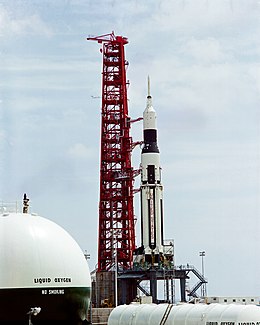A-101 (spacecraft)

AS-101 (SA-6)
|
|
| Mission type | Spacecraft aerodynamics |
|---|---|
| Operator | NASA |
| COSPAR ID | 1964-025A |
| SATCAT no. | 800 |
| Mission duration | ~5 hours, 53 minutes |
| Orbits completed | 54 |
| Spacecraft properties | |
| Spacecraft | Apollo BP-13 |
| Launch mass | 7,700 kilograms (17,000 lb) |
| Start of mission | |
| Launch date | May 28, 1964, 17:07:00 UTC |
| Rocket | Saturn I SA-6 |
| Launch site | Cape Kennedy LC-37B |
| End of mission | |
| Disposal | Uncontrolled reentry |
| Last contact | May 28, 1964 after 4 orbits |
| Decay date | June 1, 1964 |
| Orbital parameters | |
| Reference system | Geocentric |
| Regime | Low Earth orbit |
| Perigee | 178 kilometers (96 nmi) |
| Apogee | 199 kilometers (107 nmi) |
| Inclination | 31.7 degrees |
| Period | 88.26 minutes |
| Epoch | 30 May 1964 |
|
|
|
AS-101 (also designated SA-6) was the sixth flight of the Saturn I launch vehicle, which carried the first boilerplate Apollo spacecraft into low Earth orbit. The test took place on May 28, 1964, lasting for four orbits (about six hours). The spacecraft and its upper stage completed a total of 54 orbits before reentering the atmosphere and crashing in the Pacific Ocean on June 1, 1964.
The flight experienced a single anomaly: one of the eight first-stage Saturn I engines shut down early, but the guidance system compensated by burning the remaining seven engines longer. AS-101 was followed by four more flights to verify the launch aerodynamics of the Apollo Command and Service Module and its Launch Escape System (LES) tower.
The first five launches of the Saturn I had carried Jupiter-C nosecones, a proven design which allowed engineers to focus on development of the rocket. To verify the launch aerodynamics of the Apollo Command/Service Module (CSM), AS-101 carried BP-13, a boilerplate spacecraft which weighed 17,000 pounds (7,700 kg) and duplicated the size and shape of the CSM, and a dummy Launch Escape System (LES) tower. A flight-weight Command Module weighed around 12,000 pounds (5,400 kg). The boilerplate spacecraft was instrumented with 116 sensors reading strain, pressure, and acceleration.
It took three attempts to launch the rocket from Cape Kennedy Air Force Station Space Launch Complex 37B. The first attempt was scrubbed after the liquid oxygen damaged a wire mesh screen during a test, causing fuel contamination. The second attempt was scrubbed after the rocket's guidance system overheated due to failure of an air conditioning compressor.
The vehicle finally lifted off on May 28, 1964. There had been several delays during the count as liquid oxygen vapors obscured an optical window in the SA-6's instrument unit, so that a ground-based theodolite could not see it. This theodolite was required by the countdown computer in order for launch to proceed. Engineers deemed it non-critical and reprogrammed the computer, allowing the launch to proceed.
...
Wikipedia
